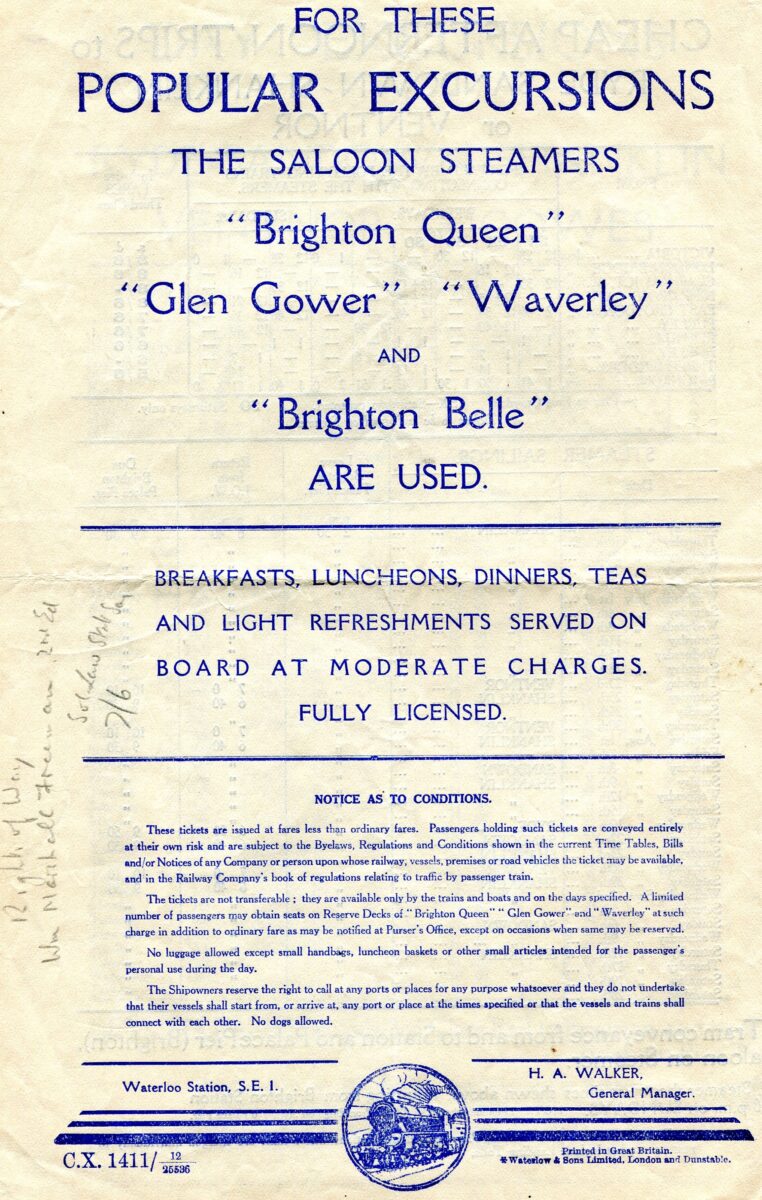
On Saturday 1st August 1936 the Southern Railway and P & A Campbell offered a joint cheap afternoon excursion from London to the Isle of Wight by fast electric train to Brighton thence by paddle steamer from the Palace Pier to Shanklin (weather and other circumstances permitting).

You could have boarded the 12.30pm non-stop express from London Victoria which would have got you into Brighton in just one hour for arrival at 1.30pm. Or you could have caught the 12.30pm from London Bridge which called at East Croydon, Redhill and Three Bridges along the way which would have got you into Brighton for 1.43pm.
Then there was a short bus or tram ride from the station down to the Palace Pier for which the steamer notice recommended that “25 minutes should be allowed” to join the paddle steamer for the sea trip along the Sussex Coast to Shanklin which would have been reached shortly before 5.30pm for an hour ashore.
Return from Shanklin was at 6.40pm for arrival back at Brighton at 9.30pm with onward connection by any train back to London on the same day.
These excursions were offered on 34 afternoons from Sunday 6th June to Saturday 26th September. They mostly called at Shanklin but sometimes it was Sandown or Ventnor instead.
There were also 29 day excursions offered to this formula from Thursday 4th June to Tuesday 29th September with departure times from London from 7.46am and from Brighton varying between 9.50am and 11.30am with destinations including Cowes, Ryde, Sandown, Shanklin or Ventnor.

Unusually P & A Campbell based four, instead of three, paddle steamers at Brighton in 1936. I don’t know which of Brighton Queen, Glen Gower or Waverley were rostered on this day but I think that we can be pretty sure that it wasn’t Brighton Belle, which usually ran the more local excursions and particularly from Eastbourne and Hastings.

The return fares, including third class on the railway, were 8/6 (£30 in today’s money) for the afternoon excursions and 10/6 (£38 today) for the day trips.
In my view the most likely route that the captain would have taken for this voyage between Brighton and Shanklin would have been to set off on a heading of 255 degrees directly for the Looe Channel off Selsey Bill. This would have put him 2 to 3 nautical miles off the land for much of this part of the journey although he might have kept in a bit closer to the shore to give his passengers a better view of what is a rather low lying and not very scenic coast.
The distance from Brighton to the Boulder and Street buoys off Selsey Bill in the Looe Channel is 28 nautical miles so he would have passed through them about 4.30pm. Then from there across to Shanklin Pier he would have kept on exactly the same heading of 255 degrees for the further 14 nautical miles for arrival at Shanklin about 5.30pm.
255 degrees is quite a good heading with the prevailing SW wind fine on the port bow outbound and fine on the starboard quarter homeward bound so not too much rocking and rolling if it was a bit blowy.
The one downside of taking the Looe Channel is that, in my experience, the Boulder and Street buoys are small and so are very hard to spot until you are nearly upon them. Just to the north of them are some spiky rocks called the Malt Owers, The Dries and the Mixen. So these are potential hazards in darkness or poor visibility.
Alternatively he could have kept further out to sea taking a heading of 245 degrees from Brighton which would have taken him south of the Owers Bank and the then Owers Lightship. The lightship was a distance of 23 nautical miles from Brighton and would have been rounded about 4.10pm. He would then have come round onto a heading of 275 degrees for the 19 nautical miles on to Shanklin. This course would have put any sea from the prevailing SW winds a little bit more on the beam so would not have been so comfortable for the passengers. But it would have taken him very clear of the rocky dangers near the inshore passage.
Another factor in choosing the route would have been the tide. With a favourable tide going with him he would have had more benefit from that outside the Owers. If he had been punching the tide there would have been a little less tide against him in the inshore passage.
These trips were targeted at a better off clientele from London looking for something exotic to do to fill up a long afternoon and evening or a full day out from the Capital. How nice to speed down to the seaside on one of those new and fast electric trains and then take a paddle steamer ride to such an overseas destination as the Isle of Wight. Then to be able to get home to your own bed in Richmond, Hampstead or Clapham the same night. And be ready for work again tomorrow. What-ho!
Kingswear Castle returned to service in 2023 after the first part of a major rebuild which is designed to set her up for the next 25 years running on the River Dart. The Paddle Steamer Kingswear Castle Trust is now fund raising for the second phase of the rebuild. You can read more about the rebuilds and how you can help if you can here.
John Megoran
This article was first published on 1st August 2021.


